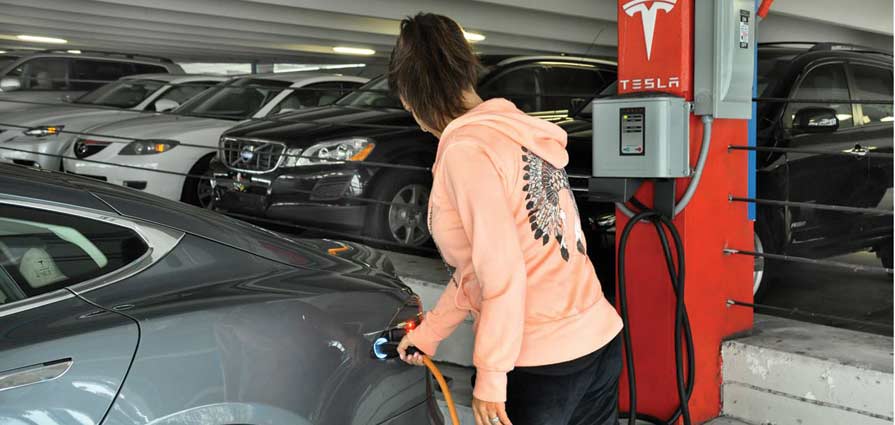Finding that electric vehicle plug-in

Could a shareable system of electric vehicles (EVs) be used along US 1 in Miami-Dade County to complement current transportation infrastructure? The EV/Infrastructure Alliance thinks it’s a possibility.
But to get the infrastructure for an electrified car sharing system, funding and a more rapid permitting process to get charging stations installed are required.
Two years ago Miami-Dade County partnered with the South Florida Regional Planning Council and its Florida Gold Coast Clean Cities Coalition and Florida Power and Light Co. to develop a plan for the deployment of EV infrastructure and use in Miami-Dade, Monroe, Palm Beach and St. Lucie counties. A $500,000 grant from the US Department of Energy funded the study and planning process.
The Miami-Dade US 1 Clean Transportation Corridor Project, or the US 1 Corridor Project, is just one part of that master plan, which outlines infrastructure projects and requirements for getting Miami-Dade County and others ready for the deployment of plug-in electric vehicles (PEVs).
Unfortunately at this point, money to take the plan from paper to the roads is hard to come by. “There’s no money to finance this at this point,” said Christine Heshmati, a coordinator with the regional planning council’s Southeast Florida Clean Cities Coalition. “That’s the thing with plans – there is no money to finance these things.”
What predicts personal electric vehicle ownership? Higher education, income and likelihood of any car ownership.
When those characteristics are considered and applied to Miami-Dade County, the Drive Electric Florida project found that “these characteristics imply a lower likelihood of PEV purchase.” However, in some cases quantity wins. While the makeup of Miami-Dade may point to lower than national proportions of personal electric vehicle ownership, the sheer number of people – close to 2.6 million—means that there will be a large number of personal EVs in the county over the next decade, Ms. Heshmati said. However, at the time of study, Miami-Dade had .6 Priuses less than Broward per 1,000 residents.
The plan predicts that by 2017, there will be over 4,300 personal electric vehicles in Miami-Dade and 316 to 720 charging stations.
Electric vehicles and the infrastructure to support them, from knowledgeable mechanics to charging stations, go hand in hand, and there are a few obstacles in the way of charging station accessibility and installation in the county.
Because multi-unit dwellings make up nearly 50% of the housing units in the county – more than twice the national percentage – access to charging stations at home is a challenge for a large portion of Miami-Dade residents, the project found.
In order to entice personal electric vehicle purchase and get more charging stations on the road, breaking down barriers to obtaining charging stations permits could help, like targeting high-volume locations for those stations.
“From a government point of view, if you can streamline permitting procedures for example, that could be something local government should do,” Ms. Heshmati said. And as it turns out, Miami-Dade might not need many charging stations. For this county, it’s quality of location over quantity.
“We don’t need hundreds of charging stations in the south, but we do need some more,” she said. To get public charging stations, funding will have to come from somewhere.
“But it doesn’t take that much compared to other alternatives,” Ms. Heshmati said. “If there were funding through some type of central source… there are local governments that are of a more regional nature. If they chose to spend some of their funding on this, it would benefit more than one county.”
The Miami-Dade US 1 Corridor project stretches along the US 1 Metrorail from the Civic Center to the intersection of South Dixie Highway and Howard Drive. The master plan found a demand for approximately 140 shared electric vehicles for 12 Metrorail stations.
To get started, the plan recommends placing 50 electric vehicles to demonstrate initial interest, along with 12 dedicated charging and EV care stations. The 12 stations are the Civic Center, Culmer, Overtown, Government Center, Brickell, Vizcaya, Coconut Grove, Douglas Road, University, South Miami, and Dadeland North and South.
The 12 stations were singled out because they account for 77% of the system’s use, with nearly 40,000 average annual daily boardings, the plan reports. In order to facilitate use, it is proposed that the electric vehicles be allowed to use the Miami-Dade Busway.
More so than in 2012 when the master plan was being developed, there is a precedent for car-sharing in Miami-Dade. Established organizations like Car2Go have found success throughout the county and have been able to capitalize on unique Miami events like Art Basel.
For its part, Miami-Dade County currently has a small fleet of electric vehicles.
Today, Miami-Dade has two fully electric Nissan Leafs issued out of the downtown motor pool. Ignacio Ortiz, a county spokesman, reports that three Prius vehicles have also been converted to plug-in hybrids. Charging stations can be found sporadically around the Miami area today, in parking garages and malls, though there are no public county charging stations, Mr. Ortiz said.
One EV and charging station at a time seems to be the motto today.







Recent Comments